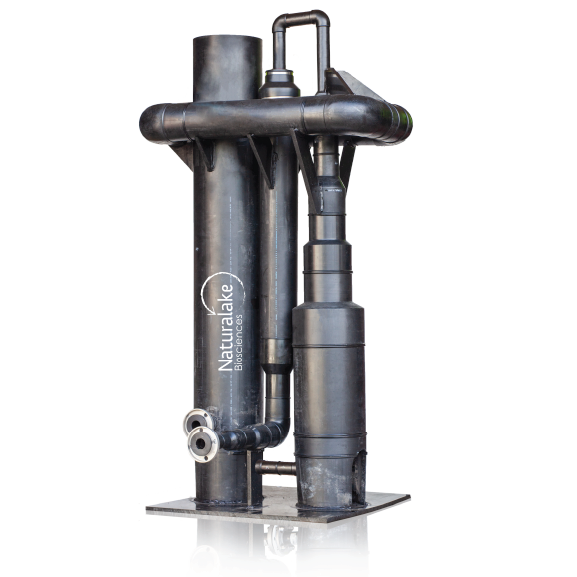
3 Reasons Why OST ™ Will Change Fisheries Management Forever
by Patrick Goodwin, M.S., CLM
The standard two-step aeration procedure in fisheries management hasn’t changed in 60 years: Bottom-diffused aeration plus a series of surface aerators. The bottom-diffused aeration systems are used to prevent large volumes of dead water from accumulating while the surface aerators are used to help boost surface level oxygen levels. They are both needed on a fishery-managed lake to reduce the risk of fish kills and help reduce ammonia. While this two-step approach is better than not having any system installed it is limited in what it can offer fisheries managers who are trying to grow many big fish. Ultimately this approach cannot guarantee an oxygen-related fish kill won’t occur or that ammonia will not build up. The intense water mixing also warms bulk water causing temperature stress on fish. We are entering a new era in oxygen management with breakthrough technologies like Oxygen Saturation Technology ™ (OST). Here are 3 reasons why OST will change fisheries management forever.

1. Ammonia Stress
Ammonia directly affects fish production and growth. It is the by-product of fish and other decaying organic material. It is constantly being added to lakes, especially in highly stocked fishponds or lakes with lots of bottom organics. Any level of ammonia will cause some impairment to fish. Low levels of ammonia will reduce fish feeding and make them more susceptible to bacterial infection while higher levels will affect their gills and internal organs causing death. In healthy ponds with high oxygen, the levels of ammonia should be zero. Factors influencing ammonia are loading (how much fish and/or organics are present), oxygen, temperature, and pH. The more fish stocked or the more organics on the bottom the more loading of ammonia to the lake. Dissolved oxygen (DO) is inversely related, the lower the level of oxygen the higher the ammonia level, and vice versa. Water temperature and pH are directly related, the higher the water temperature and pH the higher the ammonia levels are. Traditional aeration systems cannot achieve 12 mg/L DO 24-7 365 to eliminate ammonia buildup from occurring. They are also counterintuitive by warming the entire volume of water via mixing, warmer water means more ammonia. Intensive aeration may increase ammonia concentration because it can suspend pond sediments. On the other hand, OST can completely oxidize ammonia to nitrate once high oxygen levels are met. There is no mixing of sediments or warming of water that would exacerbate ammonia levels.


2. Temperature Stress
Each species of fish has an optimal temperature to grow. If fish are outside their optimal temperature, they will become stressed making them lethargic reducing the overall feeding and their percent feed conversion rate (weight of feed intake divided by weight gained). For example, for large-mouth bass, the maximum limit for optimal growth is ~80°F. In the southeast USA, it is not uncommon to have surface water temperatures approaching 90°F during much of the summer. Traditional aeration attempts to homogenize water temperatures to increase oxygen levels but at the cost of removing any cool water refuge. The warmer bulk water also increases water evaporation rates by 2-4 times, something that can be important in water-scarce regions or where the cost to pump new water is high. From a fishery standpoint, traditional aeration causes heat stress on largemouth bass for 3 or so months each year reducing their ability to grow and put on weight. OST maintains cool and cold-water refuge eliminating heat stress and enhances warm water fisheries like largemouth bass by giving them ~3 or so more months of optimal temperature growth. The higher oxygen levels achieved by OST, and subsequent improved water quality further promote fish growth and production. No doubt new records for growing large-mouth bass and other fish will be done using OST. We are also entering uncharted areas with OST giving fisheries managers the ability to stock cold water species like rainbow trout in the southeast USA. If your lake is deeper than ~25ft you have cold enough water to stock cold water fish.

Figure. 4 Fish growth rate in relation to water temperatures.
3. Carrying Capacity
As a fishery manager trying to grow record largemouth bass we want to have as much bait fish as possible, so the bass doesn’t have to expel energy to capture its food and lose weight. Or if you are growing fish to re-sell for profit you want to maximize the amount of fish grown per volume of water. This is all a function of the lakes’ carrying capacity which is a term used to define the equilibrium between the availability of habitat and the number of fish the habitat can support over time. More fish added means more ammonia waste and oxygen consumption. Exceeding the lakes carrying capacity can lead to poor growth rates, disease, and even death. There is no surprise that aerated ponds have greater carrying capacities than non-aerated ponds. But traditional aeration has its limitation in the level of oxygen it can achieve, which is often 40-60% oxygen saturation over a 24-hr period. With the invention of OST, we are now looking at a new tier for how much fish can be held in water. OST allows for a pre-set non-climatically driven dissolved oxygen level to be maintained continuously 24-7 365 days a year. OST eliminates oxygen and ammonia issues allowing for an additional 3-fold increase in lake carrying capacity over traditional aerated ponds. It also offers 20-40% in annual electrical savings over traditional aeration.

About the Author
Patrick Goodwin, M.S., CLM, is a Water Resource Specialist at Natural Lake Biosciences, with over ten years of experience in water resource management. Specializing in data collection to evaluate nutrient loading and the consequences of that loading in terms of algal blooms and water clarity. Patrick has successfully restored multiple water bodies and is considered an expert in oxygenation and circulation techniques.


